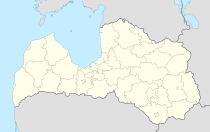Vangaži
| Vangaži ( German : Wangasch) | ||
|---|---|---|
 |
|
|
| Basic data | ||
| State : |
|
|
| Landscape: | Livonia ( Latvian : Vidzeme ) | |
| Administrative district : | Inčukalna novads | |
| Coordinates : | 57 ° 6 ' N , 24 ° 33' E | |
| Residents : | 3,778 (Jan 1, 2016) | |
| Area : | 5.1 km² | |
| Population density : | 741 inhabitants per km² | |
| Height : | ||
| City law: | since 1991 | |
| Website: | www.vangazi.lv | |
| Post Code: | ||
| ISO code: | ||
Vangaži ( German Wangasch ) is a town with 3839 inhabitants (as of July 1, 2014) in central northern Latvia . In 2016 Vangaži had 1,402 inhabitants.
history
The place name is a combination of the two Livonian words vang (field) and aži (place). Vangaži is mentioned for the first time in the 17th century as the name of a manor . There has been a monastery here since the 17th century. In the 19th century, a number of manufactories emerged , especially for the production of paper, glass and copper utensils.
Large deposits of sand and gravel were discovered in 1955. In 1961 the workers' settlement "October" became part of Vangaži. In 1957 a concrete factory was founded . In 1991 Vangaži was granted town charter.
Sports
1968–1991 Vangaži had a relatively strong football club, first called Celtnieks Vangaži , then renamed Betons Vangaži . This even played 1989-1991 in the Virslīga , the highest football league in Latvia.
See also
literature
- Hans Feldmann , Heinz von zur Mühlen (Hrsg.): Baltic historical local dictionary, part 2: Latvia (southern Livland and Courland). Böhlau, Cologne 1990, ISBN 3-412-06889-6 , pp. 680-681.
- Astrīda Iltnere (ed.): Latvijas Pagasti, Enciklopēdija. Preses Nams, Riga 2002, ISBN 9984-00-436-8 .
